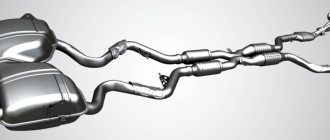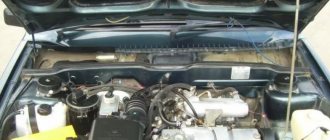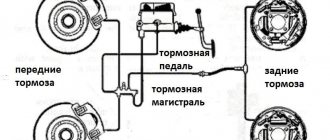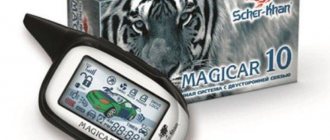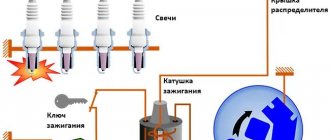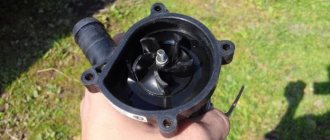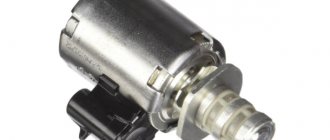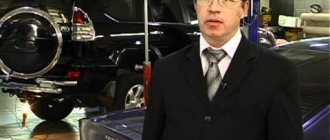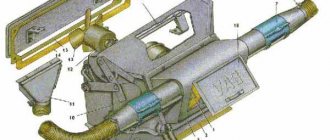The parking brake, which is commonly called the handbrake, is used in all modern cars. In addition to the fact that the system of this brake allows you to park the car even on sites with a slope, it also acts as an emergency (spare) brake. At the same time, the handbrake is essentially a continuation of the hydraulic brake system existing in a car or motorcycle. Their malfunctions may be similar, but this is only a first impression. Let's figure out how the handbrake works, what components the handbrake system includes, and what breakdowns are typical for such a system.
A little about the functions of the handbrake
The main function of a handbrake is to hold the vehicle in one place for a long time. Second function : providing braking in case of an accident or emergency braking. In fact, the handbrake is also a braking device at the same time. It can not only save the driver and his passengers in an emergency, but also simply helps to park the vehicle normally.
In sports cars, the handbrake can also be used to make particularly sharp turns. On such vehicles, the brake lever is not located in the same way as in urban vehicles. By the way, on some trucks and even SUVs the handbrake may look quite ordinary, but in reality it interacts not with the wheels, but with the car transmission. Here the subtleties are in the details. Let's look at some points.
Spring energy accumulators [ edit | edit code]
On trucks and buses with a pneumatic brake drive (for example, on KAMAZ vehicles), spring energy accumulators are installed in the brake chambers, braking the vehicle not only in operating mode, but also when parked or in the event of an accident (reduction of pressure, failure of the air compressor, breakage of the brake hose). To park, the driver reduces the pressure in the pneumatic system, the straightening springs reliably press the brake pads to the drum. They release the brakes, increasing the air pressure. When towing an emergency vehicle (on a rigid hitch), it is necessary to unscrew the bolts in the energy accumulators, compressing the springs. [7]
Handbrake device
Speaking about the design of the parking brake, we will not pay much attention to each of the elements, of which there are at least fifteen in the handbrake. It is enough for a competent car enthusiast to know at least the basic elements of such a brake. These include:
- Drive mechanism – pedal or lever;
- System of cables acting on the brake - one, two or three cables.
The most popular handbrake systems use three cables. Two of them are rear and only one is front. The first ones are connected directly to the brake mechanisms, while the last cable is connected to the lever or pedal. The cables are connected using adjustable ends. Each of the cables has adjusting nuts at the ends, which are needed to adjust the length of the drive. When removing the car from the handbrake, the driver activates the return spring. It is located on the front cable, sometimes on the equalizer, and in some cases directly on the brake mechanism.
Cable drive design
The handbrake device of this type, installed on the vast majority of passenger cars, is simple and provides for autonomous activation, independent of the main system. How standard service brakes function:
- The driver pressing the pedal in the cabin sets the piston of the main hydraulic cylinder in motion.
- Under the influence of the piston, pressure is created in tubes with incompressible fluid laid to all wheels.
- Transmitted to the working cylinder of the wheel, fluid pressure pushes the pistons of the drum or disc brake. In the first case, the pads are moved apart and the force of friction stops the rotation of the drum. In the second, they tightly compress the spinning disk.
For parking braking, the handbrake uses standard elements - pads, but moves them apart with its own mechanical drive, consisting of the following parts:
- the above-mentioned lever in the cabin, equipped with a locking mechanism in different positions and a push-button unlocking device;
- the main cable connected to the lever and ending with a mounting bracket or an arcuate guide;
- secondary cables connected to the main one and connected to the brake levers of the rear wheels;
- cable adjustment mechanisms (spacers, nuts and springs), suspension brackets to the underbody;
- spacers between the pads.
Note. The main cable is connected to the rear drum mechanisms in two ways: with one cable hooked in the middle to a guide, or with two separate drives.
The rod system is usually hidden under the bottom in the recess of the central tunnel. Cable drives are equipped with protective covers that prevent corrosion. How does a mechanical handbrake work:
- The driver lifts a handle in the cabin, which automatically locks into the selected position.
- The traction moves the main cable forward, and it carries the secondary drives along with it through a mounting bracket.
- A lever inside the drum mechanism rotates and pushes the upper ends of the shoes apart. The automatic regulation function is taken over by the spacer bar.
- When the driver removes the car from the handbrake, the springs inside the drums tilt the lever back and the pads move. At the same time, the spring pulls the cable drive back to its original position.
The parking brake described above locks the drum wheels mounted on the rear axle. On cars equipped with brake discs, the same principle works: a cable pulls a lever, which causes the pads to compress. The only difference is the location and shape of the lever - on disc brakes it is placed outside, behind the hub.
Handbrake in a car with disc brake
Spare parts for Mazda 2
Front bumper
1.3 ZJ-VE
Spare parts for Mazda 3
Steering rack/mechanism oil seal (see sizes) 1.6 Z6
The most common disc brake systems can use one of three handbrake systems. It’s difficult to talk about the advantages and disadvantages here - each system is adapted to specific brakes and interacts best with them. The parking brake is divided into:
- Screw;
- Drums;
- Cam.
The screw system has found application in disc brakes equipped with only one piston. The piston is controlled by a screwed-in screw. The screw rotates due to the lever from which the cable is pulled. In a slightly more complex cam system, the brake system pistons are manipulated using a pushrod driven by a cam. It is also connected to the handbrake lever using a cable. As soon as the cam rotates, the tappet and therefore the piston begin to move. The drum system has found application in brakes equipped with several pistons.
General recommendations when using the parking mechanism
- Most often, a parking blocker is used for short-term parking, which is not designed for a long time. But situations are different, so if the main system fails, you can also apply the parking brake.
- The handbrake is used when performing certain maneuvers, but you must be an experienced driver.
- Experts do not recommend using the parking brake when parking for a long time (more than a week) or, for example, in the winter. There is a good chance that the handbrake will freeze, and the wheels of your car will remain immobilized for a long time. You should also check the handbrake once a month to avoid breakdowns and accidents.
If you are just planning to “master” the car and have no experience yet, keep in mind that the parking brake can play a cruel joke on you when passing the exam. This may be due to your inattention and not releasing the brake. Be careful to avoid awkward situations.
From all of the above, it follows that the braking force should be such that it quickly stops the wheel, but does not block it. Since braking force also depends on vehicle weight and tire friction coefficient, the importance of tire condition and ground conditions at the time of braking is emphasized. A worn tire reduces the coefficient of adhesion and therefore the effectiveness of the brakes. The same thing happens when the tire loses contact with the road due to ground conditions due to rain, mud, snow, etc. these conditions reduce the torque on the wheels, so the applied braking force must be less to prevent the vehicle from sliding.
Types of parking brakes
In a separate article, we have already looked at the design of the automobile braking system. Not much attention was paid there to the handbrake, but its fundamental structure was still described. The key element of a handbrake is the actuator . It could be as follows:
- Mechanical;
- Hydraulic;
- Electromechanical , otherwise called EPB.
The simplest drive is mechanical. It is also the most common - a mechanically operated parking brake lever can be seen in most cars. The parking brake is controlled through this lever. Due to the tension of the cables, the wheels are blocked, which allows you to reduce the speed of the car or prevent the wheels from spinning when parked. A more complex hydraulically driven handbrake is much less common. Structurally, the most complex electromechanical parking brake, otherwise called simply EPB , consists of the following elements:
- Brake mechanism;
- Drive device;
- Control system (electronic).
Electric drive . Includes belt drive, electric motor, planetary gearbox and screw drive. As soon as the electric motor is switched on, it transmits rotation through a belt drive to the planetary gearbox. The latter uses a screw drive. The planetary gearbox makes the entire system less noisy and lighter. As is the case with all handbrake mechanisms, the electromechanical parking brake acts on the pistons of the brake system.
Hydraulic system tuning
Hydraulic drive is used in most modern machines. A simple and reliable device, a minimum of complex and fragile parts, allow it to remain in service even in the age of electronic computing and control units that have replaced many mechanical elements in the design of a car. A simple diagram includes:
- master brake cylinder;
- expansion tank;
- pressure regulator;
- two brake circuits, for the front and rear wheels of vehicles.
When you press the pedal, pressure is created in the system, which is transmitted to the brake cylinders located in the wheels, which press the pads against the surface of the discs or drums. Unlocking when pressure is removed is performed using a return mechanism.
The operation of the hydraulic handbrake will become clearer after watching the next video. Many car enthusiasts, dissatisfied with the way the mechanical parking brake drive works, decide to modify the main brake system. The hydraulic hand brake is installed on the circuit that serves the rear wheel mechanisms. All elements of the mechanical drive are mercilessly removed.
In appearance, the handbrake used for modification is practically no different from its mechanical “brother”. The same handle with an unlock button, the same ratchet mechanism, but instead of a central cable there is a hydraulic cylinder, not much different from the GTZ of the main system.
External view of a hydraulic hand brake.
Now the pressure in the brake circuit responsible for the rear wheels of the car can be created not only together with the front circuit, as happens during normal operation of the main system, but also by tightening the handle of the hand parking brake.
Diagram of installing a hand brake in the hydraulic system of a VAZ car.
The main advantage of this type of modification is ease of maintenance. The hydraulic drive of the parking brake operates without a force equalizer on the right and left wheels. According to Pascal's law, which describes the behavior of fluid in communicating vessels, the pressure at all points of the brake circuit will be the same.
The main disadvantage is a decrease in the reliability of the system as a whole. The mechanical parking brake drive operated independently of the hydraulic service brake system. Now, a breakdown of the circuit and loss of fluid threatens to leave the car without an emergency stop.
More information about the electromechanical handbrake
Continuing the topic of the EPB device, we will also touch on the electronic control unit. It includes the control unit itself, input sensors and an actuator. The transmission of input signals to the unit is controlled by at least three control elements - buttons on the central car console, an integrated slope sensor and a clutch pedal sensor located on the clutch drive. The block itself, having received the signal, gives a command to the operating devices, such as the drive motor.
The nature of EPB operation is cyclical, that is, the device turns off and then turns on again. Switching on can be done using the already mentioned buttons on the car console, but switching off is automated - as soon as the vehicle moves, the handbrake will turn off. However, by pressing the brake pedal, you can turn off EPB by pressing the corresponding button. When releasing the brake, the EPB control unit analyzes the following parameters: the position of the clutch pedal, as well as the speed of its release, the position of the gas pedal, and the inclination of the vehicle. By taking these parameters into account, the system can be turned off in a timely manner - the risk of the car rolling away, for example, on a slope becomes zero.
Electromechanical EPB is the most convenient and at the same time effective on cars with an automatic transmission. It performs well when operating a vehicle in large cities, where alternating starts and stops occurs very often. Advanced systems have a special “ Auto Hold ” control button, by pressing which you can temporarily stop without the risk of the car rolling away. This is useful in the already mentioned city - the driver will only need to press this button instead of constantly holding the brake pedal in the down position.
Of course, the advanced electromechanical parking brake seems futuristic and extremely convenient. In fact, there are at least 3 shortcomings that negatively affect the popularity of EPB. But let’s also touch on the advantages of the system:
- Advantages : compactness, extreme ease of operation, no need for adjustment, automatic shutdown at start, solution to the problem of car rollback;
- Disadvantages : high cost, dependence on the battery charge (if it is completely discharged, you will not be able to remove the car from the handbrake), inability to adjust the braking force.
The main disadvantage of EPB only occurs under certain conditions. If the car is idle for a long time, the battery will have time to discharge - there is no secret in this. For owners of a working city car, this problem is rare, but if the vehicle really needs to be left in the parking lot for some time, you will either have to get a charger or keep the battery charged. As for reliability, practice has shown that EPB is inferior to more familiar handbrake systems in this parameter, but only slightly.
Features of operation
When operating a vehicle with a mechanical brake, it is recommended to observe the following rules:
- lower the handbrake before starting to move, otherwise the wear of the brake pads and discs will accelerate;
- do not put the car on the “handbrake” in winter, as at this time of year the pads may freeze to the discs;
- Always raise the handbrake in cars with automatic transmission and the “Parking” function, as this will prevent the car from rolling back.
On vehicles with EPB, the condition of the electromechanical parking brake must be checked regularly. The mechanism must not be left running for an extended period of time. Because of this, the battery quickly discharges, as a result of which it becomes impossible to move away. In addition, when carrying out repair work on the car, the EPB electronics must be switched to service mode. This will help avoid additional breakdowns.
Author: Fedor Averyev
Parking brake malfunctions
The fairly simple design of the braking system ultimately became its weakness - many not-so-reliable elements make the entire system unreliable. Of course, a car enthusiast does not encounter a handbrake malfunction very often, but statistics show that during the operation of the car, its owner has studied the issue of parking brake malfunctions at least once. Here's what he might have noticed:
- The travel of the drive lever has increased. With this option, one of the following is observed: the length of the rod has increased or the gap between the drum and the shoes in the corresponding brake systems has increased. In the first and second cases, adjustment is needed, but in the second, optionally, the pads may need to be replaced;
- There is no braking. The options are as follows: jamming of the release mechanism, “oiling” of the pads, everything that is indicated in the paragraph above. This will require disassembling the mechanisms and cleaning them. Adjusting or replacing the pads will help solve the problem;
- There is no disinhibition. Simply put, the brakes get very hot. It is necessary to check whether the brake mechanism is sticking, whether the gaps are set correctly, and also to ensure that the tension springs are in good condition. Disassembly, cleaning and, optionally, replacement of components will solve the problem with brake release.
Single fault: Problem with brake warning light . It may not burn or may not burn in all cases. In this case, the problem most likely lies in the car’s electrical system. If you have to work directly with the handbrake mechanism, then be prepared in advance to buy a handbrake cable. Only the original cable lasts a long time, but most automakers determine that the service life is not the most impressive: about 100 thousand kilometers. Simply put, during the life of the car you will have to replace the cable or adjust its tension at least once.
Checking the parking brake is extremely simple: place the vehicle on an inclined surface, then tighten the lever until it stops. The vehicle should not budge, but the corresponding light on the panel should light up. If any of the above did not happen, you need to repeat the test. If the result does not change, you will have to work on the handbrake again or check the electrical system.
Checking service [ edit | edit code ]
In accordance with the “List of faults and conditions under which the operation of vehicles is prohibited” (appendix to the Traffic Rules)
It is prohibited to operate the vehicle
:
1.5. The parking brake system does not ensure a stationary state:
- vehicles with a full load - on a slope of up to 16 degrees inclusive;
- passenger cars and buses in running order - on a slope of up to 23 percent inclusive;
- trucks and road trains in equipped condition - on a slope of up to 31 percent inclusive.
To check the parking brake at home, you can tighten it all the way, engage first gear and smoothly release the clutch. When the parking brake is working properly, the engine should stall until it comes to a complete stop. If the car is moving slowly, something is wrong.
Selecting handbrake elements
Hand brakes are produced by the same companies that specialize in brake consumables, calipers and repair kits. You can search for, say, a handbrake cable using several parameters. Which one to choose is up to the owner of the car or motorcycle. Here are the parameters we are talking about:
- Vehicle data. In particular, the make and model, as well as the year of manufacture;
- Original part code. If the buyer has saved analogue codes, it will not be difficult to find the originals;
- VIN code. A parameter that the vehicle owner knows for sure.
Today, vehicle owners are increasingly looking for the necessary spare parts based on car/motorcycle data . This method would not be accurate if online stores did not create their own cross-databases and did not work on search systems for electronic catalogs. By specifying the brand, model, and selecting the part you are looking for from the list, you can quickly determine the code of the original or analogues, as well as place an order.
A very important factor in choosing handbrake parts is who made it. You should give preference either to original components or to products from companies that have partnerships with automakers. Good hand brake components can be found under the names of the following companies:
- TRW (Germany);
- Cofle (Italy);
- Metzger (Germany);
- ABS (Netherlands);
- LPR (Italy);
- FTE (Germany);
- Valeo (France).
It is important to note that the products of all the above companies are counterfeited, and quite often . Manufacturers from Italy are especially “problematic”. Parking brake components from Bosch (Germany) are also often counterfeited, and much less frequently – from Adriauto (Italy). Carefully inspect each product and its packaging. The slightest discrepancies in design, mechanical damage and sloppy printing indicate that the auto part is a fake.
Hydraulic and electronic wheel locks
The hydraulic drive device includes an additional cylinder built into the fluid circuits of the rear wheels. Outwardly, it resembles a regular “handbrake”, inside of which there are pistons connected to the handle. For blocking, a standard working system is used, which operates by compressing the liquid.
When the driver pulls on the hydraulic parking brake, the pistons create pressure only in the fluid circuits of the rear wheels, causing the stock wheel cylinders to clamp the disc or drum with the pads. The disadvantages of this design and operating principle are obvious: if the line leaks or the rear hydraulic cylinders break, the handbrake will also stop functioning normally. There will be nothing to secure the car with.
The principle of operation of the electromechanical “handbrake” is as follows:
- When it is necessary to secure the car, the driver presses the corresponding button in the cabin, giving a command to the electronic control unit.
- The controller includes two electric motors with gear mechanisms located on the rear wheels.
- The motors compress the pads around the brake disc using screw drives. Since the linings wear out over time, the controller determines the stroke length using a sensor.
- To turn off the handbrake, you need to press the button again. The electronic unit will give a command to the engines, which will release the pads.
Reference. On some brands of Japanese cars, activation of the electric brake occurs differently: after activation, a special servo drive located in the cabin begins to move the rod of a conventional cable system and locks the rear wheels in the traditional way.
A disadvantage of electronics is loss of functionality in the absence of power supply (for example, the battery is discharged or removed). The second point: mechanisms with motors are installed together with disc brakes; a cable and rods are used to block the drum brakes.
The electronic handbrake has many more positive qualities:
- A forgetful car enthusiast will not drive with the parking brake on. When the engine starts and the car moves off, the controller will force the electric motors to release the pads.
- To disable the wheel lock, it is not enough to press the button again. The driver must fasten his seat belt, start the power unit and put his foot on the brake pedal.
- On a vehicle equipped with an electric handbrake, the Auto Hold anti-recoil safety feature is available. It works simply and reliably: the wheel locking is automatically activated whenever the car stops with the engine running. This allows you to move off safely on any slope.
An electric handbrake, controlled by a controller, increases driving safety and is much less likely to fail than a cable drive. The simple mechanical version breaks due to stretching or jamming of the cables due to rust and dirt. During operation, the drive must be constantly tightened, otherwise the pads will only engage in the upper position of the lever.
Conclusion
Despite its simple design, the parking brake does not fail very often. A competent car enthusiast should know how this brake works and what malfunctions are typical for it. In the event of a malfunction, repairs can be carried out even by a non-specialist - all you need are tools, spare parts, a little time and, optionally, cleaning products. Fortunately, all this can be found in a wide range even in small stores. We strongly advise against ignoring handbrake malfunctions, because this brake not only allows you to safely park your car on a slope, but is also responsible for emergency braking.
Application situations [edit | edit code]
- Starting on a steep hill;
- Parking on site;
- Brief exit from the car (gas station, store, etc.)
- Prolonged use of the main brake (parking in a traffic jam, in front of a traffic light, etc.);
- Failure of the main brake system. In the event of an emergency, you need to brake by sharply and strongly pulling the brake handle, avoiding prolonged friction of the brake pads on the drum, since in this case the friction linings and mechanism overheat and the maximum braking torque decreases;
- To enter a controlled drift.
Long-term storage of a car with the parking brake is not recommended, as the pads may stick (and freeze in the cold season) to the drum.
Instructors at driving schools teach how to skid park by engaging first gear, turning the steering wheel and pulling the handbrake (this technique is mainly used in emergency preparation).
«>
Advantages and disadvantages
This device has its pros and cons. Let's start with the cons:
- It has been proven that the braking efficiency of this type of mechanism is slightly lower than that of disc mechanisms. The braking distance is almost 20% longer. This is due to the following reasons: insufficient contact area, which is not provided even by two cylinders, and the resulting slipping, which is caused by dust that has penetrated into the mechanism.
- Overheating of the drums due to lack of cooling; when braking, the temperature of the drums can rise to 6000 degrees.
- A reduced maximum load value, at high pressure, can rupture the drums with liquid pressure.
However, not everything is so bad; there are also undeniable advantages of this mechanism:
- The closed design allows you to get good braking force, and you can increase the friction surface by making the drum wider and the pads too. This is what ensured the widespread use of such a mechanism on all trucks and buses.
- The degree of resistance to wear and the service life of the linings is increased, which is caused by less frictional contact than with a disc brake.
- Good protection against dirt getting inside, which the disk version does not have.
I won’t say whether disc or drum brakes are better; passenger cars mostly have disc brakes, but they are not suitable for buses and trucks.
